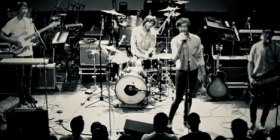This is an excellent read I came across regarding streaming and producer royalties. Take notes & ENJOY!
PMP Question:
“Hey Bernie, with music streaming becoming more popular than paying to download a single or album I wanted to know how much does a producer get paid per stream and is there still a mechanical as well as publishing royalty involved with music streaming?”
Bernie’s Response:
Prior to answering the first question “how much does a producer get paid per stream”, I must first identify “how music producers get paid when their music is being streamed”.
Music streaming services is the newest and cheapest way to consume music today. It allows consumers to listen to music in ‘real time’ without having to download a file onto their computer or mobile device. Some of the more popular streaming services include: Apple Music, Spotify, YouTube, Google Play Music, Amazon Prime, Pandora, iHeart Radio, Slacker Radio, Last.fm, SoundCloud, and Tidal. Consumers have a choice to either pay a subscription fee for the service or use free streaming services. Either way, the streaming services company still has to pay revenues for the use of music. Per the Copyright Royalty Board, the 2016 rate for commercial subscription services is $0.0022 per performance (per 100 streams); for commercial non-subscription services, it $0.0017 per performance (per 100 streams). Record labels pay artists on a per album basis, and thus, 1500 streams is equivalent to the sale of one (1) album. Today artists are faced with the question of whether it’s financially beneficial to use music streaming services to exploit their music. Music producers, on the other hand, want to know how to get paid from recordings they produce that are being streamed. My initial question to them is “whether they fit into one of the following categories: 1) recording digital performance or 2) songwriting digital performance or 3) both.
The function of streaming recordings is classified as a digital performance. A steaming services company pays a recording digital performance royalty to a nonprofit entity called SoundExchange. SoundExchange monitors and collects recording digital performance royalties and pays the sound recording owner/record label owner or artist/performer. They do not pay songwriters. SoundExchange pays fifty percent (50%) of the royalties to copyright owners/record labels, forty-five percent (45%) to artists/performers (those considered “featured performers” on a recording) and the balance of five percent (5%) is paid to a fund (i.e. American Federation of Musicians (AFM) and SAG-AFTRA) for non-featured artists (i.e. musicians, background singers, engineers).
When we think of a “recording”, we have to consider the performances that are embodied on the recording. A music producer performs the arrangement and production of a recording. Their performance is embodied in the recording and thus, they should be considered a “featured performer” of the recording, entitling the producer to receive recording digital performance royalties. However, such right is not automatic. In order for that to occur, the artist/performer must execute a letter of direction, which authorizes SoundExchange to pay a portion of the artist’s recording digital performance royalties to producer. If a letter of direction is not executed by the artist/performer, the music producer will not receive any recording digital performance royalties collected by SoundExchange for the exploitation of such particular recording.
If the artist agrees to execute a letter of direction, the next question is how much of the artist income is the music producer entitled to receive as a “featured performer”? Well, SoundExchange does not provide a mathematical equation to the public, but instead allows such specifics to be determined by the parties involved. In many instances, a lawyer representing the artist will take into account the royalty rate payable to the producer for a track being sold (i.e. 3% of the RLSP in respect to the net sales) and divide it by the artist royalty rate (i.e. 16%) to determine a proper royalty payable to the producer (i.e. 18.75%). However, some lawyers may argue that the producer’s performance embodied in the recording is just as important as the artist and thus, should receive a pro rata share equal to their ownership interest in the musical composition or controlled composition. Such argument mainly works in situations where the music producer has more leverage.
Let’s review a hypothetical mathematical equation to help put things in perspective. An independent artist that owns their own record label or content uploads one (1) track that receives 10,000 streams from a subscription services site. For every 100 streams, the artist receives a net royalty of .22¢. 10,000 X .22¢ equals $22.00. Half of such royalty is paid out to the artist as the content owner; then 45% (or $10.45) is paid to the artist as the performer, and the balance of 5% (or .55¢) is paid to a fund for non-artists (musicians). Out of the $10.45, the artist agreed to pay the music producer a royalty of 18.75% via the featured artist letter of direction. The music producer is expected to receive a net royalty of approximately $1.96 or 20% of the artist net royalty.
In addressing the second part of your question “is there still a mechanical as well as publishing royalty involved with music streaming?’ my response is as follows:
Under copyright law, there are two references to music copyrights: 1) copyright in the sound recording, and 2) copyright in the musical composition. Generally, mechanical royalties are paid to songwriters in connection with the sale of a recording (i.e. digital download or physical sale). A streaming services company (i.e. Pandora, Spotify, Beats, etc.) that engages in “on-demand” services, however, is deemed a sale and a performance and pays mechanical royalties to agencies in the U.S. like the Harry Fox Agency, every time a song written by a particular songwriter is streamed, but will not pay mechanical royalties to an individual songwriter. Such streaming services companies will also pay a songwriting digital performance royalty to performance rights organizations or PROs (i.e. ASCAP, SESAC, BMI). ASCAP and BMI, both nonprofit organizations, are governed by consent decrees, which makes them subject to rates set by the U.S. Department of Justice rate courts. In other words, they cannot negotiate their own rates. SESAC, however, is a for-profit entity, and is not subject to the same restrictions as ASCAP and BMI. It is important to note that in the United States, songwriter performance royalties are paid out solely through PROs. SoundExchange is not a PRO. Further, recording digital performance royalties should not be confused with the ability to collect neighboring rights royalties, which is payable to sound recording owners (i.e. record label owners and performers) for the public performance of music via satellite radio, internet radio, international terrestrial radio and TV (a discussion to be covered in a separate article).
In closing, the most important take-away is as follows: 1) music producers should obtain a signed SoundExchange featured artist letter of direction to be submitted to SoundExchange for payment. Otherwise, producers will potentially miss out on substantial revenue, if the recording becomes successful. To find out more about the SoundExchange featured artist letter of direction, click here: https://www.soundexchange.com/wp-content/uploads/2015/06/Guide-to-Letter-of-Direction.pdf 2) The producer should sign up with a PRO to collect performance royalties; and 3) the producer, as an independent songwriter/publisher, should sign up with the Harry Fox Agency to collect mechanical royalties.
Disclaimer: The contents of this article are the express opinion of Bernie Lawrence-Watkins and shall not to be construed as legal advice or in any way create an attorney-client relationship.
© 2017 Bernie Lawrence-Watkins. All Rights Reserved.
via PMP






